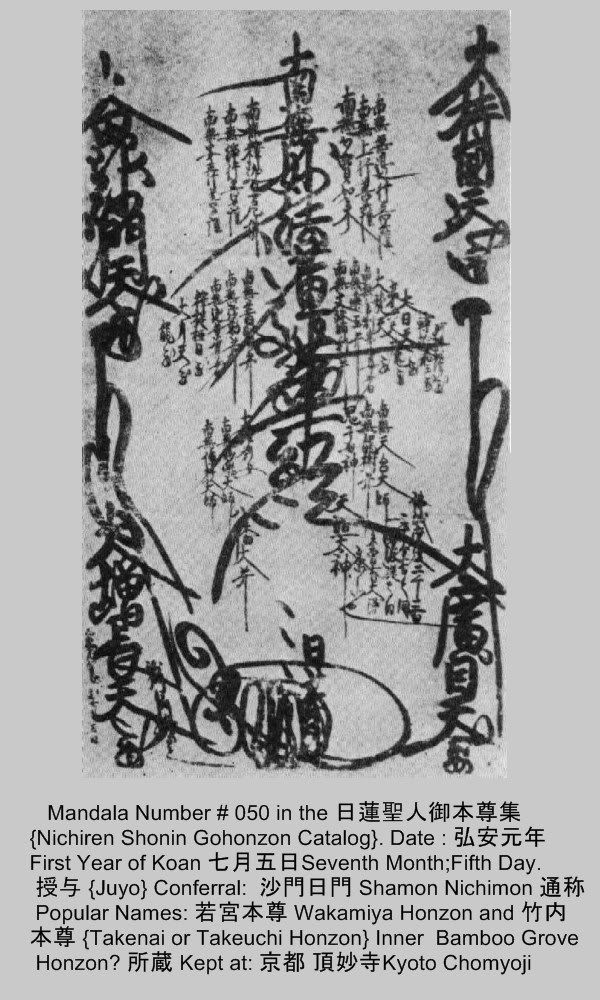- Date : 弘安元年 First Year 年 of Koan 七月五日Seventh Month; Fifth Day. {July 05 1278}
- 授与 {Juyo} Conferral: 沙門日門 Shamon Nichimon
- 通称 Popular Name: 若宮本尊 Wakamiya Honzon and 竹内本尊 {Takenai or Takeuchi Honzon} Inner Bamboo Grove Honzon?
- 讃文 Nichiren's Laudatory Inscription: 仏滅度後二千二百三十余年之間一閻浮提之内未曽有大漫荼羅也 {Butsu-metsu-do-go ni-sen ni-hyaku san-ju yo nen no aida ichienbudai no uchi mi-zo-u dai-man-da-ra nari}. After the Buddha's passing, there has been an interval of more than 2230 years. Moreover, In between then and now, this Great Mandala was unheard of in this world.
- Material: Paper 3 紙 Sheets
- Dimensions: 53 X 94.9 cm or 20.86 x 37 3/8 inches.
- 所蔵 Kept at: 京都 頂妙寺 Kyoto Chomyoji

The conferral {juyo} notation is to Shamon Nichimon. Shamon is a transliteration of the Sanskrit Sharmana. DDB translates Shamon as "Wandering Monk." I can not find anything about Nichimon. The date is the First Year of Koan, Seventh Month; Fifth Day; or July 5th 1278. That is the same date as the Rinbo Gohonzon {# 051}; which it resembles. It is also similar to the Bhikkhu Nikken Honzon {# 052} from the same month.
Mandala # 50 has two popular names. I am not sure of the reading of either. One is likely the Wakamiya Gohonzon. Wakamiya is a street in Kamakura leading to the Hachiman Shrine; the site of Nichiren's famous scolding of Hachiman, on 12th September, 1271. The other popular name is read either Takeuchi or Takenai. Take is used as a translation of the Sanskrit Venu, meaning Bamboo Grove. It can just mean bamboo. Uchi or nai is used as a translation of adhyatma; meaning internal or personal, It can also mean inner, within, home, house, hut, between, or among. Takeuchi is also a common Japanese given or surname.
Mandala # 50 has two popular names. I am not sure of the reading of either. One is likely the Wakamiya Gohonzon. Wakamiya is a street in Kamakura leading to the Hachiman Shrine; the site of Nichiren's famous scolding of Hachiman, on 12th September, 1271. The other popular name is read either Takeuchi or Takenai. Take is used as a translation of the Sanskrit Venu, meaning Bamboo Grove. It can just mean bamboo. Uchi or nai is used as a translation of adhyatma; meaning internal or personal, It can also mean inner, within, home, house, hut, between, or among. Takeuchi is also a common Japanese given or surname.


No comments:
Post a Comment